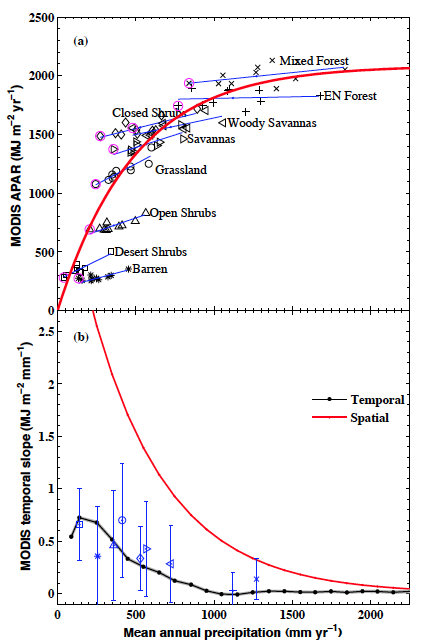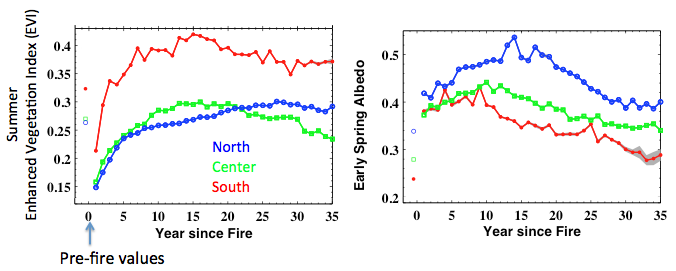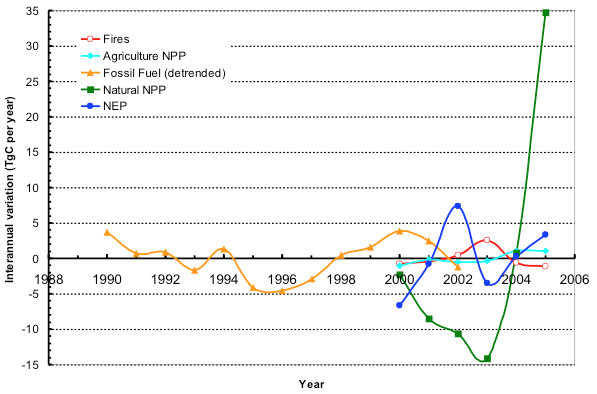Ecological Dynamics
Impact of salinity on orchard evapotranspiration
Recent prolonged droughts in California have emphasized the urgent need to implement more efficient water management practices for high value tree crops. Understanding how crop consumptive water use is limited by various environmental stressors is critical for improving management of micro-irrigated pistachio orchards grown in the San Joaquin Valley of California.
 The mean annual crop season estimated ET (mid-March to mid-October in 2016) with remote sensing decreased by 32% from 1064 ± 99 mm in the non-salt affected control orchard to 725 ± 82 mm in the orchard with the highest level of soil-water salinity. The ET reduction was consistent with canopy volume differences among the study orchards. The available energy was controlled mostly by canopy features and explained 64% of daily ET variation. The normalized differenced water index (NDWI) could be considered as an important parameter to capture the partitioning of available energy for ET (R2 = 0.38), suggesting that the lower soil osmotic potential in saline orchards further reduced crop ET.
The mean annual crop season estimated ET (mid-March to mid-October in 2016) with remote sensing decreased by 32% from 1064 ± 99 mm in the non-salt affected control orchard to 725 ± 82 mm in the orchard with the highest level of soil-water salinity. The ET reduction was consistent with canopy volume differences among the study orchards. The available energy was controlled mostly by canopy features and explained 64% of daily ET variation. The normalized differenced water index (NDWI) could be considered as an important parameter to capture the partitioning of available energy for ET (R2 = 0.38), suggesting that the lower soil osmotic potential in saline orchards further reduced crop ET.
Related publication: Jin, Y., R. He., G. Marino, M. Whiting, E.Kent, B. Sanden, M. Culumber, L. Ferguson, C. Little, S. Grattan, K. T. Paw U., L. Lagos, R. Snyder, and D. Zaccaria (2018), Spatially Variable Evapotranspiration Over Salt Affected Pistachio Orchards Analyzed with Satellite Remote Sensing Estimates, Agricultural and Forest Meteorology, 262, 178-191, 10.1016/j.agrformet.2018.07.004.
Ecosystem response to precipitation variability
 Water availability is a major regulator of net primary production in arid and semi-arid regions. A clear distinction between short- vs. long-term ecological response to precipitation variation is needed to anticipate the ecological consequences of climate change. We used a long time series of satellite data to derive gridded information on ecosystem productivity and separated the spatial and temporal responses of diverse ecosystems across a large productivity and climate gradient throughout California. Long-term mean annual productivity increases with mean precipitation spatially across the landscape and leveled off over wetter areas. The temporal sensitivity of productivity to year-to-year precipitation variation is much lower than that derived from the spatial relationship. The interannual response decreases over the driest areas, limited by the growth potential, and decreased over wetter areas due to light or nutrient constraints, resulting in the highest sensitivity in grasslands. This study indicates the impact of changing precipitation in California will depend strongly on temporal scale and the prediction of the ecological consequences of future precipitation change depends on whether the equilibration process is rapid or gradual.
Water availability is a major regulator of net primary production in arid and semi-arid regions. A clear distinction between short- vs. long-term ecological response to precipitation variation is needed to anticipate the ecological consequences of climate change. We used a long time series of satellite data to derive gridded information on ecosystem productivity and separated the spatial and temporal responses of diverse ecosystems across a large productivity and climate gradient throughout California. Long-term mean annual productivity increases with mean precipitation spatially across the landscape and leveled off over wetter areas. The temporal sensitivity of productivity to year-to-year precipitation variation is much lower than that derived from the spatial relationship. The interannual response decreases over the driest areas, limited by the growth potential, and decreased over wetter areas due to light or nutrient constraints, resulting in the highest sensitivity in grasslands. This study indicates the impact of changing precipitation in California will depend strongly on temporal scale and the prediction of the ecological consequences of future precipitation change depends on whether the equilibration process is rapid or gradual.
Related publication: Jin, Y. and M. L. Goulden (2013), Ecological consequences of precipitation variation: separating short- vs. long-term effects using satellite data, Global Ecology and Biogeography, doi: 10.1111/geb.12135. [PDF]
Post-fire vegetation recovery trajectories
 Most information on post-fire succession in the boreal region to date comes from chronosequence studies comparing communities of different ages, or direct observations of post-fire species composition and tree densities. Our studies demonstrated the capability of time series of satellite observations in tracking the varying rates of vegetation recovery along burn severity and latitudinal gradients over a heterogenous landscape.
Most information on post-fire succession in the boreal region to date comes from chronosequence studies comparing communities of different ages, or direct observations of post-fire species composition and tree densities. Our studies demonstrated the capability of time series of satellite observations in tracking the varying rates of vegetation recovery along burn severity and latitudinal gradients over a heterogenous landscape.
Related publications:
Jin, Y., J. T. Randerson, M. L. Goulden, and S. J. Goetz (2012), Post-fire changes in net shortwave radiation along a latitudinal gradient in boreal North America, Geophysical Research Letters, 39, L13403, doi:10.1029/2012GL051790. [PDF]
Jin, Y., J. T. Randerson, S. J. Goetz, P. S. A. Beck, M. M. Loranty, and M. L. Goulden (2012), The influence of burn severity on post-fire vegetation recovery and albedo change during early succession in North American boreal forests, Journal of Geophysical Research-Biogeosciences, 117, G01036, doi:10.1029/2011JG001886. [PDF]
Mechanisms for interannual C variations in California
 We used the CASA biogeochemical model driven by climate and satellite vegetation index to estimate net primary production (NPP) and net ecosystem exchange (NEP) and compared various mechanisms that control the interannual variation in California's carbon budget. California’s NPP (185 TgC yr-1) was roughly double its fossil fuel emission (96 TgC yr–1) during 2000-2005. The net C budget was dominated by fossil fuel emissions, considering ecosystem carbon storage is typically less than half NPP. We also found that the magnitude of interannual variation in NPP caused by climate variability is 23 TgC yr-1; Ttotal NEP by 18.4 TgC yr-1. Fire emissions varied by 2.9 TgC yr-1. The fluctuations in fossil fuel emission is 8 TgC yr-1, smaller than that of the ecosystem NEP, but larger than that caused by fire.
We used the CASA biogeochemical model driven by climate and satellite vegetation index to estimate net primary production (NPP) and net ecosystem exchange (NEP) and compared various mechanisms that control the interannual variation in California's carbon budget. California’s NPP (185 TgC yr-1) was roughly double its fossil fuel emission (96 TgC yr–1) during 2000-2005. The net C budget was dominated by fossil fuel emissions, considering ecosystem carbon storage is typically less than half NPP. We also found that the magnitude of interannual variation in NPP caused by climate variability is 23 TgC yr-1; Ttotal NEP by 18.4 TgC yr-1. Fire emissions varied by 2.9 TgC yr-1. The fluctuations in fossil fuel emission is 8 TgC yr-1, smaller than that of the ecosystem NEP, but larger than that caused by fire.


